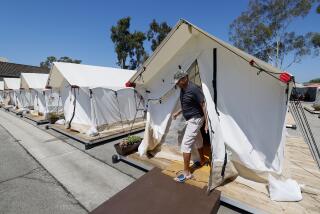STYLE / DESIGN : DOME, DOME ON THE RANGE
- Share via
Domed and bug-like, today’s tents are halfway between houses and space capsules. Miracles of weightlessness and strength, they unfold into geometries unfathomable to almost everyone except theoretical physicists while creating spare but comfortable interiors. As designers across the country continue to tailor each pole, flap and fly more precisely to its function, their research and development (field-tested on many a busman’s holiday) is producing tents that look as though they’ve been invented on Mars.
Unless you’ve been camping lately, your mental image of a tent might be your grandfather’s unwieldy wood-and-canvas A-frame. Fortunately, that went the way of the tepee when former Ford designer Bill Moss of Ann Arbor, Mich., came up with his domed Pop Tent in 1955. A flexible arch of fiberglass rods, the Pop Tent was almost as easy to use as an umbrella and provided more shoulder room to boot. Several simple domed tents followed in the ‘60s and ‘70s, including those from Adventure 16 of San Diego, Jansport of Everett, Wash., and Sierra Designs of Emeryville, Calif. In the mid-’70s, The North Face in Berkeley transformed tents again, this time turning Buckminster Fuller’s geodesic dome into an even sturdier, more stable portable enclosure using lightweight aluminum tubes. Ever since, designers have been creating variations on the geodesic theme, incorporating evermore refined materials and construction techniques along the way.
“The perfect shape is still the true geodesic dome--that hasn’t changed in two decades,” says Andy Burgess, a senior product manager for The North Face, “but it is very expensive and only makes sense for large tents. When they get smaller, concerns about weight, where your body goes and how you get in and out of the tent take over.” The result is aerodynamically sleek tents made up of curves that intersect and hold one another in balance. The most basic shapes, such as Moss Tents’ Little Dipper and Starlet, resemble unfurling flowers when viewed from above: Each section of stretched fabric emanates naturally from the symmetry of the tent poles.
Things get more interesting with tents such as North Face’s Himalayan Hotel, Star Ship Extreme and Lightspeed, whose shapes arise from the subtle relationships between asymmetrical curves. Here, each pole seems to be straining against another. When the curves intersect, they form tents with big faces that seem to stare at you and rear ends that appear to shrink into the landscape. There’s a logic to these shapes: Many provide more room in the front of the tent, where you can sit up and move about in comfort, and less room in the back, where you lie down to sleep.
Making the designs possible are lightweight but durable materials such as aluminum alloy tubing. Borrowed from the archery industry, the aluminum tubes help a heavy-duty tent to withstand fierce winds while enabling a light-duty tent to pack down to as little as four pounds, less than a laptop computer. Breathable ripstop nylon functions well in cold weather and warm; nylon mesh windows and doors improve ventilation. And polyurethane-coated flysheets, or tent covers, shed rain and snow.
These tents undergo testing, of course, in company labs and under real-life conditions. After a camping or climbing expedition, for instance, prototypes are taken apart and analyzed. Everything, from how your hand grips a zipper (the “fumble factor”) to which colors enhance your mood, is studied and used in designing the next line. “The tents you take to the Himalayas are yellow on the outside so you can spot them in a snowstorm,” Burgess says. “But the color also gives a nice golden glow on the inside, which makes you feel better when you have to spend a lot of time in that small space waiting out a snowstorm.”
Knowing that even the smallest details have been considered is no doubt reassuring to those packing a tent off to the Andes. For those of us who may get no farther than our back yards, though, such design decisions allow us to see a world of shapes that in itself is a revelation amid the rigid forms of the city. In that way, we are happy campers all.
*
Stylist: Cathy Cooper; hay bale and saddle courtesy of Bar S Stable/Horse Rentals, Glendale
Location: Chateau Marmont
More to Read
Sign up for The Wild
We’ll help you find the best places to hike, bike and run, as well as the perfect silent spots for meditation and yoga.
You may occasionally receive promotional content from the Los Angeles Times.






